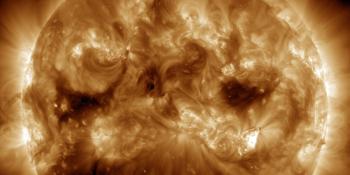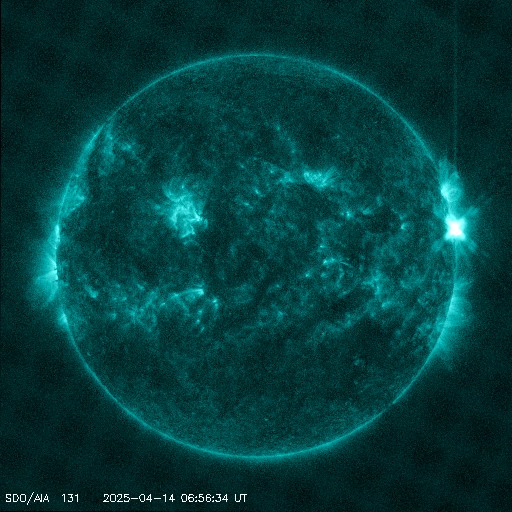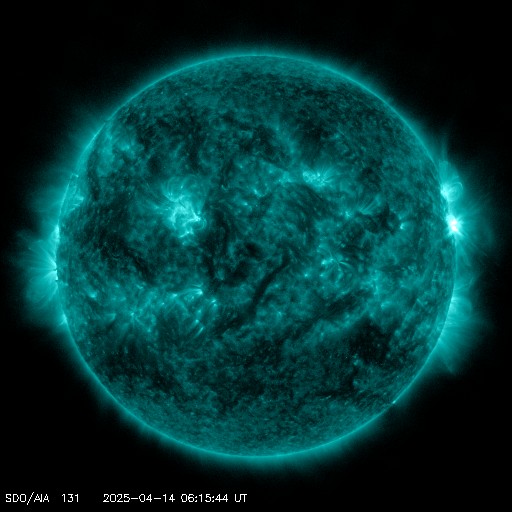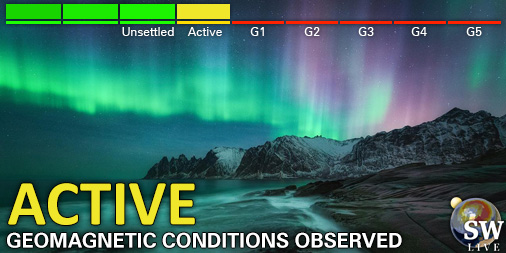Viewing archive of Friday, 7 January 2005
Solar activity report
Any mentioned solar flare in this report has a scaling factor applied by the Space Weather Prediction Center (SWPC). Because of the SWPC scaling factor, solar flares are reported as 42% smaller than for the science quality data. The scaling factor has been removed from our archived solar flare data to reflect the true physical units.
Report of Solar-Geophysical Activity 2005 Jan 07 2200 UTCPrepared by the NOAA © SWPC and processed by SpaceWeatherLive.com
Joint USAF/NOAA Report of Solar and Geophysical Activity
SDF Number 007 Issued at 2200Z on 07 Jan 2005IA. Analysis of Solar Active Regions and Activity from 06-2100Z to 07-2100Z
Solar activity was very low. Region 715 (N06w59) has
decayed to a small single polarity sunspot. New Region 718 (S09E78)
was numbered today and was responsible for occasional B-class
flares. Another active region is rotating into view near S12.
IB. Solar Activity Forecast
Solar activity is expected to be very
low to low. Isolated C-class activity is possible from active
regions near the southeast limb.
IIA. Geophysical Activity Summary 06-2100Z to 07-2100Z
The geomagnetic field ranged from quiet to major storm levels.
Transient flow, likely the CME activity from 04 and 05 January,
impacted the geomagnetic field first at around 07/0900Z. The
existing elevated solar wind speed increased from 500 km/s to just
over 600 km/s. The major storming followed a period of sustained
southward Bz to near -10 nT between 07/1300 - 1500Z. A second
disturbance passed the ACE spacecraft at 07/2010Z. Only a weak
enhancement was observed on the plasma measurements; however, the
IMF Bz turned sharply southward to near -15 nT. The greater than 2
MeV electron flux at geosynchronous orbit was at high levels again
this period. The energetic electrons, which have been sustained at
high levels since 03 January, dropped below the high threshold at
approximately 07/1900Z.
IIB. Geophysical Activity Forecast
The geomagnetic field is
expected to range from quiet to major storm levels. Transient flow
from the CME activity on 04 and 05 January will continue the current
disturbance through 08 January. Periods of minor to major storming
are expected on the 8th. Quiet to active levels are expected on 09
January, before gradually returning to predominantly quiet
conditions on 10 January.
III. Event Probabilities 08 Jan to 10 Jan
| Class M | 05% | 05% | 05% |
| Class X | 01% | 01% | 01% |
| Proton | 01% | 01% | 01% |
| PCAF | green | ||
IV. Penticton 10.7 cm Flux
Observed 07 Jan 084 Predicted 08 Jan-10 Jan 085/090/090 90 Day Mean 07 Jan 105
V. Geomagnetic A Indices
Observed Afr/Ap 06 Jan 004/004 Estimated Afr/Ap 07 Jan 018/020 Predicted Afr/Ap 08 Jan-10 Jan 025/040-012/020-005/008
VI. Geomagnetic Activity Probabilities 08 Jan to 10 Jan
| A. Middle Latitudes | |||
|---|---|---|---|
| Active | 30% | 20% | 15% |
| Minor storm | 15% | 10% | 10% |
| Major-severe storm | 05% | 01% | 01% |
| B. High Latitudes | |||
|---|---|---|---|
| Active | 50% | 30% | 20% |
| Minor storm | 30% | 15% | 10% |
| Major-severe storm | 20% | 05% | 01% |
All times in UTC
Current data suggests there is a slight possibility for aurora to appear at the following high latitude regions in the near future
Oulu, Rovaniemi, SodankyläTrondheim
Arkhangelsk
Luleå, Umeå
Latest news
Latest forum messages
2025/04/12-13 Filament CMEs 2025/04/16 G2 Watch 32Unspecified geomagnetic activity 2258AR 4055 98Potential AR4062 8Incoming & Unnumbered Active Regions 1698
More topicsSupport SpaceWeatherLive.com!
A lot of people come to SpaceWeatherLive to follow the Sun's activity or if there is aurora to be seen, but with more traffic comes higher server costs. Consider a donation if you enjoy SpaceWeatherLive so we can keep the website online!

Latest alerts
07:09 UTC - Solar flare
Moderate M4.28 flare from sunspot region 4055
06:48 UTC - Radio Blackout
Minor R1 radio blackout in progress (≥M1 - current: M1.53)
06:24 UTC - Solar flare
Moderate M1.49 flare from sunspot region 4055
06:06 UTC - Radio Blackout
Minor R1 radio blackout in progress (≥M1 - current: M1.16)
04:45 UTC - Geomagnetic activity
Active geomagnetic conditions (Kp4) Threshold Reached: 04:29 UTC
Space weather facts
| Last X-flare | 2025/03/28 | X1.1 |
| Last M-flare | 2025/04/14 | M4.2 |
| Last geomagnetic storm | 2025/04/06 | Kp5 (G1) |
| Spotless days | |
|---|---|
| Last spotless day | 2022/06/08 |
| Monthly mean Sunspot Number | |
|---|---|
| March 2025 | 134.2 -20.4 |
| April 2025 | 132.1 -2.1 |
| Last 30 days | 132.4 -10.7 |





